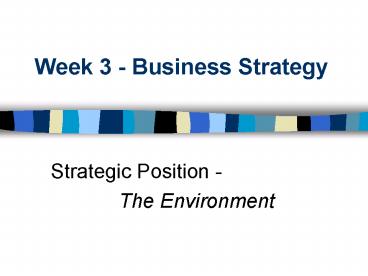Week 3 Business Strategy - PowerPoint PPT Presentation
1 / 19
Title:
Week 3 Business Strategy
Description:
Describe forces in macro-environment using PESTEL framework ... firms competing for the same spending power (Harley Davidson V conservatory, boat builders) ... – PowerPoint PPT presentation
Number of Views:37
Avg rating:3.0/5.0
Title: Week 3 Business Strategy
1
Week 3 - Business Strategy
- Strategic Position -
- The Environment
2
Learning Outcomes
- Describe forces in macro-environment using PESTEL
framework - Identify key structural drivers of change and the
differential impact on organisations - Define an industry and provide examples of
industry convergence - Use the 5 Forces Framework to identify sources of
competition - Define strategic groups and how the concept
facilitates understanding competition - Explain what is meant by market segmentation and
how it facilitates understanding what customers
value - Describe typical kinds of opportunities and
threats
3
Analysing the Environment
- Organisations do not exist in a vacuum, they are
part of a complex world. - Management should be continually aware of the
external forces which not only influence demand
for existing products and services, but also
create opportunities for new products and
services. - (Bowman and Asch, 1987, p. 60)
4
Environmental Scanning
- Before firm can formulate strategy, it needs
to scan the environment to identify possible
opportunities and threats, and its internal
environment for strengths and weaknesses - (Wheelen and Hunger, 2000, p. 53)
5
Business Strategy and Competitive Positioning
- Business Strategy focuses on improving the
competitive position of a companys or business
units products or services within the specific
industry or market segment that the company or
business unit serves - (Wheelen and Hunger, 2000, p. 113).
6
Environmental Scanning
- refers to gathering information about
external conditions for use in formulating the
firms strategies. Scanning is an important
on-going activity because it helps managers
understand and oversee the potential changes in
market demand, industry rivalry patterns, the
rise of potential substitute products, and
general macro-environmental forces that may have
long term effects on the firm. - (Pitts and Lei, 1996, p. 47)
7
PESTEL Framework
- Political (e.g. government stability taxation
policy - foreign trade regulations social welfare
policies) - Economic (e.g.business cycles interest rates
- unemployment disposable income)
- Socio-cultural (e.g. population demographics
income distribution social mobility lifestyle
changes attitude to work and leisure
consumerism levels of education) - (Johnson and Scholes, 2002)
8
PESTEL contd.
- Technological (e.g. government spending on
research government and industry focus on
technological effort new discoveries/development
speed of technological transfer rates of
obsolescence) - Environmental (e.g. environmental protection
laws waste disposal energy consumption) - Legal (e.g. monopolies legislation employment
law health and safety product safety) - (Johnson and Scholes, 2002)
9
Structural Drivers of Change
- are forces likely to affect the structure of an
industry, sector or market - look at combined effect of some of the PESTEL
factors, rather than factors separately - good example is globalisation of industries and
markets (e.g. retailing, telecommunications,
hospitality and tourism)
10
Strategic Groups
- Organisations within an industry with similar
strategic characteristics, following similar
strategies or competing on similar bases... - Look at characteristics such as product/service
diversity geographical coverage distribution
channels used extent of branding marketing
effort product or service quality technological
leadership size) - (Johnson and Scholes, 2002, pp. 123-4)
11
Identifying Competitors
- firms offering similar product/ utilising similar
technology (e.g. Penguin V Twix six pack) - firms operating in same product category (e.g
Penguin V crisp manufacturer) - firms offering products which deliver same
service (e.g. long-distance coach firm V
railways, cars, etc.) - firms competing for the same spending power
(Harley Davidson V conservatory, boat builders) - (Wilson and Gilligan, 1997, p. 122)
12
Sources of Competition
- Industry Analysis
- 5 Forces Framework (Porter)
- Industry Groups (Johnson and Scholes)
- Determinants of National Advantage
- Porters Diamond
13
5 Forces Model (Porter)
14
Porters Diamond - Determinants of National
Advantage
Firm Strategy, Structure and Rivalry
Demand Conditions
Factor Conditions
Related and Supporting Industries
15
Understanding Markets and Market Segments (J S,
2002, p. 127)
- Success or failure of organisation also depends
on understanding customer needs and on ability to
meet them - Market segmentation - identifying similarities
and differences between groups of customers and
users
16
Understanding What Customers Value
- Important to see value through the eyes of the
customer or the stakeholder - Difficult however, because value is
multi-dimensional - Useful to think of perceived customer value
- Use information at hand
- (J S, 2002, pp. 130-131)
17
Opportunities and Threats
- Using frameworks just detailed, managers can
identify new market space to gain competitive
advantages - Look for Strategic gaps to fill, for example
- across substitute industries
- across strategic groups
- across complementary product and service
offerings - new market segments
18
SWOT Analysis
- A SWOT analysis summarises the key issues from
the business environment and the strategic
capability of an organisation that are most
likely to impact on strategy development - (Johnson and Scholes, 2002, p. 134)
- Next weeks lecture focuses on strategic
capability, the internal environment and
strengths and weaknesses
19
Summary
- macro-environmental factors which impinge upon
business strategies - impact of environmental influences on the firm
- various sources of competitive advantage
- markets, market segments, what customers value
- opportunities and threats































